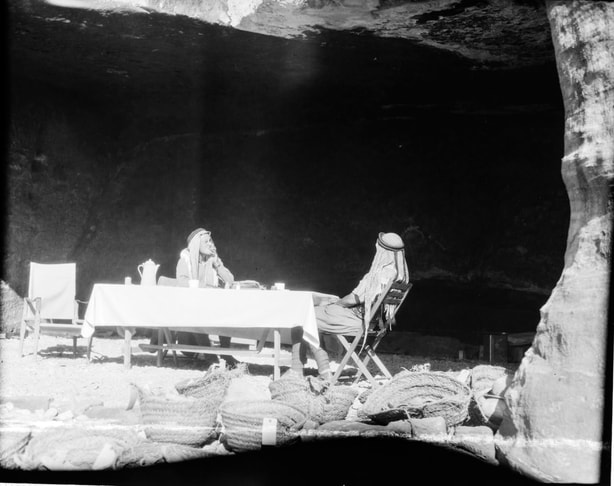|
[by Agnes Conway and George Horsfield] Dr. Nielsen spent the day working at the Sanctuaries on El Habis, and felt that he had discovered enough in one morning to justify his journey. This complex of cult monuments, all orientated to the west, seem to him to be the earliest Arabian sanctuaries, circa the 2nd millennium B.C. He thinks that the bulls heads on the so-called “pulpit” and the cone shaped top, somewhat resembling a coil, of snakes, are of human workmanship, though much weathered. (He turned this down afterwards). A.E.C. spent the morning and afternoon exploring the Wady El Tughra. Below El Habis, S of the sanctuaries, she found what might almost be called a cemetery of shaft graves, some leading into large tomb chambers below. All were of solid construction and considerable depth, but the roofs in all cases had gone and the contents were rifled. One shaft grave had 3 small detached obelisks near it, and the holes for the bases stood at the head of the grave 1. The graves on the opposite side of the Wady under El Bijara are much later. Two sumptuous Nabataean temple graves have later partition walls of large stones, regularly built (prob. Bedouin?). One large tomb with a niche for a single grave has only a small hole knocked out of the slab and might be worth exploring for its contents. Following the Wady southwards a large irregular lump of sandstone in the middle (the Kegelberg) is also a collection of shaft graves, and further on on the western side are a few shaft graves in front of some of the largest Hellenistic tombs. The green plateau between the Wady and the W. face of El Biijara is a mass of large worked stones, probably Greco-Roman and looked to her like remains of the town. Where the Wady en Mer runs into the Wady el Tughra are a few rock-hewn caves, almost entirely silted up with sand, which might be worth excavation. G. H. started digging in mound S.W. Zubb Pharoon [sic], on the part that lies above Dalmans [sic] “Byzantine” Wall. It is covered with Byzantine pottery but the steps cut in the side of the mound produced very little. The mound in this part is composed of sand and a certain amount of burnt debris, probably from wood fires, but contained no charcoal. The sand is loose and the digging had to be done with caution for fear of a land slide. In the afternoon moved further South, where the debris is deep, and higher up the mound, which is apparently surmounted by a fortified wall which is not shown in Dalman’s plan. It breaks out from the Byzantine wall then turns until it meets the rock, with a shaft tomb. Below this lies another with slabs in place, one being broken so that you can peer in. It is partially filled with debris, and seems to have a chamber on either side. The pottery finds were poor, but a deep cutting may be interesting. The evidence so far obtained points to the wall being pre-Byzantine, as it is buried in debris of this period. Today the Camp was finished. It is situated in the Wadi Deir, in caves on both sides. In the West is the cookhouse, Living Room, W.C. and stables, and beyond a Bathroom. Dr Nielsen and Miss Conway are accommodated in tents. On the East is the Guardroom, which is also used as a Store House; adjoining is a small cave for G.H. and next door is the Guest Room. It is fairly compact, and the guard room covers all points of approach.
Many deficiencies have been discovered in the equipment, which was reduced as much as possible. These are being taken in hand, and Thos. Cook and Son’s camp, in the person of the Manager, has been most helpful. It is impossible to buy anything at Elgi, except the poorest things. No vegetables are obtainable. Milk is procurable. Chickens and sheep have to be got from the Arabs some miles away. Arrangements are beginning to work, so that all the attention of the Expedition may be given to the work of exploration. __ [Footnote]: 1. These are probably not holes for obelisks, but the ordinary ones for offerings. Mr Horsfield excavated these shaft graves later on. Reference: [unsigned, but by Agnes Conway and George Horsfield] 1929 (transcribed by A. Thornton). Petra Exploration Fund Diary. "Business Papers to be Kept", Horsfield Collection Box 8, UCL Institute of Archaeology, 26 March: 6-9. Comments are closed.
|
Categories
All
Archives |

 RSS Feed
RSS Feed